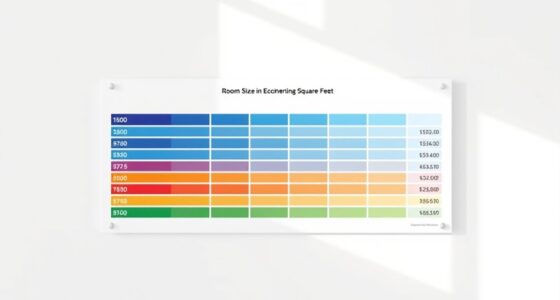Your sensor’s PM2.5 and PM10 readings tell you about different particle sizes in your indoor air. PM2.5 particles are tiny and can reach deep into your lungs and bloodstream, risking long-term health issues like heart disease. PM10 particles are larger and mostly affect your nose and throat, causing coughing or irritation. Understanding these differences helps you take better steps to improve your air quality—keep going to learn how to interpret these signals for a healthier home.
Key Takeaways
- PM2.5 readings indicate fine particles that can penetrate deep into lungs and bloodstream, signaling long-term health risks.
- PM10 levels reflect larger particles that mainly irritate upper airways and suggest dust or outdoor pollution ingress.
- Elevated PM2.5 suggests a need for improved air filtration and ventilation to protect respiratory health.
- High PM10 levels often point to dust, dirt, or outdoor pollution entering indoor environments.
- Understanding both helps tailor specific actions to reduce health risks and improve indoor air quality effectively.

Have you ever wondered how tiny particles in the air affect your health? When your sensor detects PM2.5 or PM10, it’s not just numbers—it’s information about the air you breathe every day. These particles play a significant role in indoor air quality, which directly impacts your overall well-being. Understanding what your sensor is telling you can help you make smarter choices to protect yourself and your loved ones from potential health issues.
PM2.5 refers to particles that are 2.5 micrometers or smaller, while PM10 includes particles up to 10 micrometers in diameter. These distinctions matter because their size determines how deep they can penetrate your respiratory system. PM10 particles are larger and tend to settle more quickly, often affecting your nose and throat. In contrast, PM2.5 particles are so tiny that they can travel deep into your lungs and even enter your bloodstream. That’s why monitoring these particles is crucial when evaluating indoor air quality.
Particulate health effects are closely linked to their size. PM2.5 particles are associated with a higher risk of serious health problems, such as heart disease, lung inflammation, and respiratory illnesses. Because of their small size, they can bypass many natural defenses in your respiratory system and cause inflammation or other damage. On the other hand, PM10 particles, though larger, can still cause irritation and exacerbate existing respiratory conditions like asthma or bronchitis. They tend to be more of an immediate irritant rather than a long-term threat, but their presence indicates pollution sources that might also generate finer particles.
When your sensor detects elevated levels of PM2.5, it’s a warning sign that the air contains particles capable of causing more severe health effects over time. These readings highlight the importance of improving indoor air quality—by increasing ventilation, reducing sources of pollution like smoking or cooking fumes, and filtering air through HEPA filters. Conversely, high PM10 readings suggest there may be dust, dirt, or outdoor pollution making its way inside, which can be addressed by cleaning more frequently and sealing gaps where outdoor air enters.
In essence, understanding what your sensor reports about PM2.5 and PM10 isn’t just about monitoring numbers; it’s about safeguarding your health. Knowing the particulate health effects associated with each size helps you interpret the data better. When you take action to improve indoor air quality based on these readings, you reduce your risk of respiratory problems and support your long-term health. Your sensor is giving you valuable insights—use them to breathe easier and live healthier. Recognizing the importance of sensor data interpretation can empower you to make more informed decisions about indoor air management.
Frequently Asked Questions
How Do Weather Conditions Affect PM2.5 and PM10 Readings?
Weather conditions considerably influence your PM2.5 and PM10 readings through weather influence and particle dispersion. Wind can carry particles away or bring in pollutants from other areas, while rain helps clear particles from the air, lowering readings. Temperature and humidity also affect particle behavior, with high humidity increasing particle size and readings. So, always consider weather patterns when interpreting your sensor data for accurate air quality insights.
What Health Risks Are Associated With PM2.5 Versus PM10?
Coincidentally, the particles you’re exposed to can impact your health differently. PM2.5 poses greater risks for respiratory issues and cardiovascular problems because its tiny size allows deep lung penetration and bloodstream entry. PM10, while larger, still irritates your lungs and worsens asthma or bronchitis. Both increase health risks, but PM2.5’s ability to reach essential organs makes it particularly dangerous, especially for vulnerable populations like children and the elderly.
Can Sensors Distinguish Between Natural and Anthropogenic Particles?
You can’t rely solely on sensors to distinguish between natural and anthropogenic particles because their accuracy varies. Sensors mainly detect particle size and concentration, but identifying particle source requires advanced analysis or additional data. While some high-end sensors may incorporate source identification features, most standard devices focus on measuring particle levels, so you should interpret their readings carefully, understanding that source differentiation isn’t always precise with basic sensor technology.
How Often Should Air Quality Sensors Be Calibrated?
You should calibrate your air quality sensors at least once every six months to ensure accuracy, as calibration frequency directly impacts sensor longevity and performance. Remarkably, studies show that poorly calibrated sensors can drift by over 20% in a year, leading to misleading readings. Regular calibration helps maintain data integrity, especially in environments with fluctuating pollution levels, so don’t skip this essential maintenance step.
What Are the Limitations of Low-Cost PM Sensors?
Low-cost PM sensors often face limitations in sensor accuracy, which can impact data reliability. You might notice inconsistencies due to factors like environmental conditions, sensor quality, or calibration issues. While they provide valuable insights, you should interpret the data cautiously and consider regular calibration and maintenance. Recognizing these limitations helps you make better-informed decisions about air quality, especially when comparing readings from different sensors or locations.
Conclusion
Understanding the difference between PM2.5 and PM10 is like decoding a hidden message in the air you breathe. Your sensor reveals more than just numbers; it tells a story about potential health risks and air quality. By paying attention to these readings, you can take better steps to protect yourself, much like a lighthouse guiding ships through fog. Stay informed, stay safe—your lungs will thank you for it.









